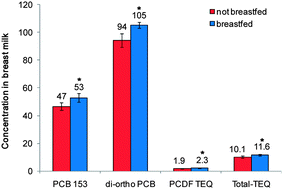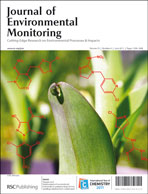We identified factors that are important determinants of body burdens (breast milk levels) of polychlorinated biphenyls (PCBs), dioxins (polychlorinated dibenzo-p-dioxins (PCDDs) and polychlorinated dibenzofurans (PCDFs)) and polybrominated diphenyl ethers (PBDEs). PCBs, PCDD/Fs and PBDEs were analysed in breast milk from up to 325 first-time mothers in Uppsala, Sweden, who delivered between 1996 and 2006. Hierarchical clustering was used as a method for identification of groups of compounds with common sources of exposure and similar toxicokinetics. Based on correlations between levels of single compounds/congeners in breast milk, distinctly separated clusters were formed, strongly dependent on structural similarities of the organohalogen molecules. In a multiple regression model, levels of PCBs (except PCB 28), PCDD/Fs and BDE-153 were positively associated with age of the mother and weight loss after delivery and inversely associated with pre-pregnancy BMI (body mass index) and weight gain during pregnancy. Higher levels of mono-ortho PCB TEQ, non-ortho PCB TEQ and BDE-153 in milk were found among women with high physical activity. Women who were breastfed during infancy and grew up on the Baltic coast of Sweden, with high availability of contaminated fish from the Baltic sea, had higher levels of PCBs and PCDD/Fs in breast milk indicating that exposure early in life from breast milk and contaminated fish may still affect body burdens at the time of pregnancy. The importance of current consumption of fatty Baltic fish as a source of exposure was supported by the positive association with breast milk levels of mono-ortho PCB TEQ, PCDF TEQ and BDE-153. The results show that, in contrast to the lower brominated PBDE congeners, the hexa-brominated BDE-153 resembles the chlorinated compounds with regards to determinants in breast milk. This suggests that some of the PBDEs may have toxicokinetic properties and that are similar to the PCBs and PCDD/Fs. Our results show that a few simple advices to women regarding weight changes in connection with pregnancy and consumption of contaminated fatty fish during the whole lifetime may lower the levels of dioxins in breast milk by up to 60%.

You have access to this article
 Please wait while we load your content...
Something went wrong. Try again?
Please wait while we load your content...
Something went wrong. Try again?


 Please wait while we load your content...
Please wait while we load your content...